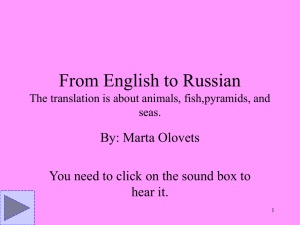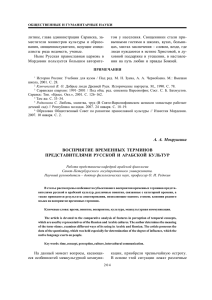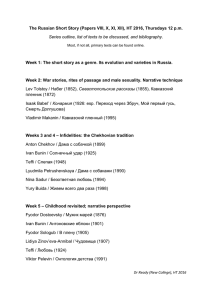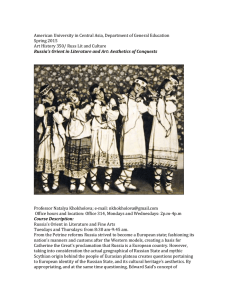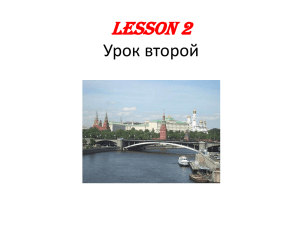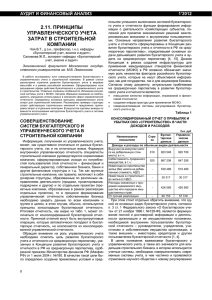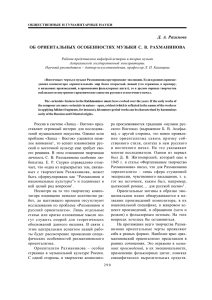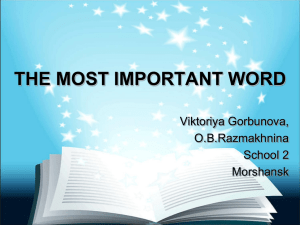
Gender and Crime in Russian History ∵ Public Meaning of the Zasulich Trial 1878: Law, Politics and Gender Tatiana Borisova Associate Professor, National Research University Higher School of Economics, St. Petersburg Abstract The article aims to demonstrate that while the jurors’ acquittal of the famous terrorist Vera Zasulich has often been interpreted in terms of sympathy for ‘a desperate girl’, previously underestimated legal and political claims also played an important role in the trial. The key legal experts at the trial – her defense attorney Aleksandrov and the president of the court Koni – interpreted Zasulich’s attempt on Trepov’s life as an act of societal self-defense: Zasulich was presented as a victim of a society which could no longer tolerate arbitrariness by authorities. The flogging of political prisoner Bogolyubov following Trepov’s illegal order made Zasulich desperate to take revenge in order to alert Russian society of the humiliating arbitrariness and the unfairness of the political and legal structures of late Imperial Russia. Her victimization highlighted her “moral right” to act as a defendant of true law and legality in Russia. This idea of “moral right,” which empowered Zasulich to act in Borisova russian history 43 (2016) 221-244 222 defense of society, was supported by Koni’s conceptualization of law and state power as an embodiment of the people’s will and responsibility. This conceptualization was elaborated in detail in his scholarly legal writings scholarship on the right to selfdefense. The article brings together Koni’s theory and his practical role in Zasulich’s acquittal and demonstrates tensions between the Great Reforms and their political and social limitations. Keywords gender – self-defense – jury trial – rule of law – terrorism – violence Introduction: A Girl against the Governor On January 24, 1878, 28 years old Vera Ivanovna Zasulich (1849–1919), a daughter of an impoverished noble family, fired at the Governor-General of St-Petersburg, Dmitri Feodorovich Trepov (1809– 1889).1 As reported by witnesses, it was immediately after her assassination attempt that Zasulich announced she had been driven to her act by the “Bogolyubov’s case,” which had occurred six months earlier, in July 1877.2 What she meant by this was Trepov’s illegal order to flog the former student Bogolyubov, who had been convicted for his participation in the Kazan Cathedral demonstration in St. Petersburg on 6 December 1876.3 Bogolyubov did not remove his hat when Trepov entered the “Kresty” prison yard. The law allowed for corporal punishment only of prisoners condemned to hard labor while en route to or at the place of their confinement. Bogolyubov’s punishment caused riots in the jail, which were documented by the St. Petersburg newspapers. The prosecutor’s office started an investigation into the use of violence while suppressing riots, but Trepov’s involvement in 1 The case of Vera Zasulich has been studied in great detail: Iu. S. Karpilenko, “Delo” Very Zasulich: Rossiikoe obshchestvo, samoderzhavie i sud prisiazhnykh v 1878 godu (Briansk: Brianskii gosudarstvennyi pedagogicheskii institut, 1994); Samuel Kucherov, “The Case of Vera Zasulich,” The Russian Review 11, no. 2 (1952): 86–96; Richard Pipes, “The Trial of Vera Z.,” Russian History 37, no. 1 (2010): v-82, Ana Siljak, Angel of Vengeance: The Girl Assassin, the Governor of St. Petersburg and Russia’s Revolutionary World (New York: St. Martin’s Press, 2008). 2 G.A. Gallanin, ed., Protsess Very Zasulich: Sud i posle suda (St. Petersburg: Sovremennik, 1906), 28. 3 For more on the Bogolyubov’s case see Pipes, “The Trial of Vera Z.,” 7–19. Public Meaning of the Zasulich Trial 1878 223 russian history 43 (2016) 221244 this story had not received any official or public condemnation before the Zasulich trial. On 31 March 1878, Zasulich’s six-hour jury trial virtually brought together these two men again: governor Trepov and political prisoner Bogolyubov. Thanks to two other men – defense attorney Piotr Akimovich Aleksandrov (1838–1893) and President of the Court Anatoly Feodorovich Koni (1844–1927) – Zasulich was acquitted by the jury, while Trepov was implicitly condemned. The acquittal was shocking to the public. Patriarch of the Russian intelligentsia Leo Tolstoy was the first to interpret acquittal of the “girl-assassin” as a subversive political act. He wrote that her acquittal was “nonsense (dur’) but of significance for the coming revolution.”4 How did the acquittal become possible and did Zasulich’s sex matter? The traditional interpretation of Zasulich’s attempt and its acquittal has been written within a broader history of the acute political crisis of Russian autocracy of the late 1860s – early 1880s, which mirrored in a chain of political trials.5 Zasulich’s acquittal by white-collar jurors has been considered as a manifestation of a new tendency of the crisis: since late 1870s the regime had found itself confronted not only by radical political terrorism but also by a growing nervousness of educated society. Studies of the Zasulich trial by historians Richard Pipes and Anna Siljak provide a contextualized narrative of events and aim to explain them in terms of both ethical grounds and political reasons. Broadly speaking, these are the political (Pipes) and social (Siljak) histories of acquittal as a result of sympathy by St-Petersburg public for “a desperate girl.” However, the interpretation of the acquittal in terms of the strong emotions of compassion, even if manipulated politically,6 is not sufficient, since, the degree of compassion was “shocking” even for justice Koni himself.7 Thus, it should be reconsidered. 4 L.N. Tolstoi to N.N. Strahov, 8 April 1878, in L.N. Tolstoi – N.N. Strahov: Polnoe sobranie perepiski, ed. L.D. Gromova et al. (Moscow, Ottava: Slavic Research Group at the University of Ottawa and the State L.N. Tolstoy Museum, 2003), 423– 424. 5 N.A. Troitskii, Bezumstvo khrabrykh: Russkie revoliutsionery i karatel’naia politika tsarizma, 1866–1882 (Moscow: Mysl’, 1978). 6 I need to note that since emotions have always played a key role in court, one can hardly divide both perspectives. On centrality of emotions to law, see a landmark collection in law and emotions scholarship: Susan Bandes, ed., The Passions of Law (New York: New York University press, 1999). 7 A.F. Koni, Vospominaniia o dele Very Zasulich (Moscow, Leningrad: Academia, 1933), 212–213. Borisova russian history 43 (2016) 221-244 224 The gender part of Zasulich’s acquittal has been limited to emotionality discourse and has not yet been sufficiently studied.8 While existing research on the female path of Russian terrorism aims to use gender-theory for historical analysis,9 “violent women” in Russian history is still a rather new theme. The Zasulich trial and its conventional interpretations provide a noteworthy case of Zasulich herself as a “feeling” rather than “politically motivated” subject.10 In this article my main research questions are: how Zasulich became a victimheroine rather than a daring heroine? What kind of legal and political theory informed such a shift and still supported her heroic status? What role did gender play in political cases such as this to reduce women to their femininity and, yet, hold the society responsible? It is necessary to answer these questions for a better understanding of why after Zasulich’s acquittal terroristic means were included in repertoire of political practices in late imperial Russia.11 In order to answer these questions I will consider key published accounts of the Zasulich trial with a special emphasis on not researched yet connection between the trial and Koni’s scholarship on the right of self-defense. In the first section I consider who were presented as the key decision-makers in the trial, and why. Then I proceed to the theoretical views of the president of the court, Anatoly Koni, on the right of self-defense. I will demonstrate that these views informed his support of the strategic plan of defense attorney Aleksandrov to bring Trepov’s order on flogging up at the trial. Then I consider the juncture of legal and gender-based arguments used by Zasulich’s defense. In the last section I consider the public dimension of Zasulich’s acquittal in terms of 8 Anke Hilbrener, “The Perovskaia Paradox or the Scandal of Female Terrorism in Nineteenth Century Russia,” The Journal of Power Institutions in Post-Soviet Societies, 17 (2016). Available at: https://pipss.revues.org/4169#ftn7. 9 Sally A. Boniece, “The Spiridonova Case, 1906. Terror, Myth and Martyrdom”, Kritika: Explorations in Russian and Eurasian History 4, no. 3 (2003): 571–606; Vera Broido, Apostles into Terrorists: Women and the Revolutionary Movement in the Russia of Alexander ii (New York: Temple Smith, 1977); Oleg V. Budnitskii, Zhenshchiny-terroristki v Rossii (Rostov-on-Don: Feniks, 1996); Barbara Alpern Engel and Clifford N. Rosenthal, eds., Five Sisters: Women Against the Tsar (New York: Knopf, 1975); Anne Hillyar and Jane McDermid, Revolutionary women in Russia, 1870–1917: A Study in Collective Biography (Manchester, New York: Manchester University Press, 2000); Amy Knight, “Female Terrorists in the Russian Socialist Revolutionary Party,” Russian Review 38, no. 2 (1979): 139–159. 10 This issue was articulated by Anke Hilbrener: Hilbrener, “The Perovskaia Paradox.” 11 Anna Geifman, Thou Shalt Kill: Revolutionary Terrorism in Russia, 1894–1917 (Princeton: Princeton University Press, 1995), Susan K. Morrissey, “Terrorism, Modernity, and the Question of Origins,” Kritika: Explorations in Russian and Eurasian History 12, no. 1 (2011): 213–226. Public Meaning of the Zasulich Trial 1878 225 russian history 43 (2016) 221-244 “compensational” actions of the “civil society of the educated.” The concluding section will place the “shocking acquittal” in the more general context of rapid social and political developments and their tensions with existing legal structures during the last decades of the Russian empire. The Lost Vera: Why Political Meaning of the Acquittal Put Zasulich Aside? Political interpretation of the Zasulich trial was elaborated in detail by the president of the court Anatolii Feodorovich Koni, who was also known as a publicist and literary critic. He played a prime role in the acquittal and was afterwards forced by the authorities to leave his post. In his detailed memoirs on the Zasulich trial Koni provided a radical and rather one-sided interpretation of the acquittal. He called it a manifestation of society’s dissatisfaction with the government.12 In other words, Koni’s interpretation of the trial was that it was yet another act in society’s struggle against the arbitrariness (proizvol) of state officials – an arbitrariness which the government did nothing to halt. A hundred years later, a historian Richard Pipes challenged this view doubting that Chancellor Gorchakov, who applauded the acquittal in the courtroom, would agree with such an interpretation. Unlike Koni, Pipes had a less radical interpretation of the acquittal and the favor with which it was greeted by “liberal” contemporaries in St. Petersburg. In line with leading St. Petersburg newspapers, Pipes provided an emotional and implicitly gendered explanation for the elitist compassion shown Zasulich – a compassion which was demonstrated in her acquittal. He put it in the following way: The timorous and bashful woman aroused compassion because she had been prepared to sacrifice her young life to punish a brutal action of a powerful and generally disliked official, not because she intended to challenge the state.13 This view of the trial shifts the emphasis away from a political struggle between state and society to what might be termed a private incident between a “timorous woman” and “a powerful and generally disliked official.”14 The collision 12 Koni, Vospominaniia, 231. 13 Pipes, “The Trial of Vera Z.,” 69. 14 Ibid. Borisova russian history 43 (2016) 221-244 226 of these two interpretations – by Koni and Pipes – has dominated the existing literature on Zasulich trial. The question of why the legal part of the process has not been sufficiently discussed should be addressed to Koni’s memoirs. The key legal figure at the trial, he provided the most detailed political account on it. It was due to his account that Trepov was presented as ‘generally disliked person’ while Koni himself and defense attorney Aleksandrov gained the victory of society over the arbitrariness of a high ranked official. This was possible due to their interpretation of Zasulich’s attempt. At the same time, her own political views were not discussed by any of them. Also, the political relevance of Trepov, as a subject was challenged by Koni. Both Zasulich and Trepov were presented as politically almost irrelevant actors. Most important was Koni’s testimony, not confirmed in any other sources, that Trepov was hesitant about whether or not he was allowed to order Bogoliubov’s flogging. In his account Koni claimed that Trepov told him that first he had come to Koni, who was close to Minister of Justice Count Palen (1833– 1912), in order to make sure that the order to flog Bogolyubov would be legal, but did not find him. So Trepov went directly to Palen and was allowed by him to order Bogolyubov’s flogging. In Koni’s interpretation Trepov did not have real power to order Bogolyubov to be flogged, nor did he have any say at the trial – the governor did not “dare” to come to the courtroom. And, finally, Koni mocks Trepov’s stupidity in telling Alexander ii that though he, Trepov, had taken Zasulich’s bullet, it was actually intended for the tsar. In furtherance of this Trepov asked the Council of Ministers to publish an official confirmation that his order in respect to Bogolyubov did not violate existing laws. According to Koni, who tells this story in his memoirs, by doing this Trepov was hoping for some kind of imperial reward. Koni writes that Alexander found this interpretation inappropriate and was angered by Trepov’s words.15 It should be noted that in his memoirs Koni himself reveals strong adherence to the Russian monarchy and to Alexander ii in particular. However, the attempt to get rid of Trepov as an important figure in Zasulich trial is not as trivial as it seems. Within the Russian autocracy, state officials were empowered and controlled by the monarch. They acted on behalf of the tsar and on the basis of the law as stipulated by him and incorporated in the Digest of Laws of the Russian Empire.16 The monarch was the central figure 15 Koni, Vospominaniia, 62. 16 I have written on this in greater detail. See Tatiana Borisova, “The Digest of Laws of the Russian Empire: The Phenomenon of Autocratic Legality,” Law and History Review 30, no. 3 (2012): 901–925. Public Meaning of the Zasulich Trial 1878 227 russian history 43 (2016) 221-244 of the functioning legal order via the administration of officials. The Digest’s creator Mikhail Mikhailovich Speranskii (1772–1839), who taught Law to the future tsar Alexander ii put this as following for his pupil: “the legislator combines within himself two honorary titles: establishing the rules he becomes a supreme interpreter of the truth; imposing the penalties he becomes its supreme protector.”17 Thus, Trepov might have implied that shooting at him, who was just a delegate of the monarch’s power, had challenged the established legal order, and its main protector – Tsar Alexander ii. That is why Trepov had a point when he asked for the publication of the official confirmation of the fact that the corporal punishment inflicted on Bogolyubov by dint of the governor’s order did not violate existing law and thus was legal. This request, according to Koni, went unfulfilled, being deemed inappropriate and somewhat untimely.18 That was the reason why Trepov attempted to highlight the legality of his order to flog Bogolyubov so as to underscore the fact that he had acted as a state entity according to state law. However, the problematic legality of his act and his own status as a delegate of sovereign power were not something that the prosecution wished to bring to light at the trial. In general, Minister of Justice Palen’s idea was to regard Zasulich’s crime as a regular criminal offense in order to prove that jury trials, as a new judicial institution, did not challenge social and political conventions.19 Also, jury trials were considered as a new progressive form of public awareness of justice, which could both promote and adjust radical social changes brought by liberal reforms of 1860s.20 Having in mind this political dimension of jury trials, which made them controversial; Palen hoped that Zasulich’s case was an easy way to demonstrate loyalty of the jury trial as such to the regime. Thus the prosecution position was to avoid discussion as to Zasulich’s motive and to consider the case as a clear 17 Mikhail Speranskii, “‘Besedy’ M.M. Speranskogo o zakonakh,” Pravovedenie 4 (1997): 63–65. 18 Koni, Vospominaniia, 501. 19 Girish Bhat, “The Moralization of Guilt in Late Imperial Russian Trial by Jury: The Early Reform Era,” Law and History Review 15, no. 1 (1997): 77– 113; Idem., “The Particulars of Guilt: Final Questions for the Jury Under the 1864 Judicial Reform,” Slavic Studies 38 (2004): 251–272. 20 See, for example, Sandra Dahlke’s detailed account on jury trial on Mother Superior Mitrofaniia, which had a “pedagogical function” to combat outdated perceptions of acceptability of personal informal power in particular the practices of protection (pokrovitel’stvo) and preferential treatment and petition (khodataistvo): Sandra Dahlke, “Old Russia in the Dock. The trial against Mother Superior Mitrofaniia before the Moscow district court (1874),” Cahiers du Monde Russe 53, no. 1 (2012): 95– 120. Borisova russian history 43 (2016) 221-244 228 private episode in which Trepov’s right to life was obviously threatened by Zasulich. So, as we have seen, from the very beginning Zasulich’s alleged crime was treated politically by the key involved men: Palen, Koni, and Trepov. Zasulich’s motivation as a politically-driven subject was not taken seriously. So already before the process and involvement of her defense lawyer, Zasulich’s role of “an emotional girl against the powerful man” was staged: her own politically driven agency was not discussed. Trepov’s attempt to underline that Zasulich’s alleged crime targeted sovereign power, which was delegated to him, was not taken seriously. In the next sections I demonstrate that Zasulich’s courageous attack on state power was addressed in terms of victim (Zasulich) versus attacker (Trepov). As I demonstrate in the following sections, this shift was possible due to a combination of the legal theory of self-defense with popular sovereignty and gender-based rhetoric. Zasulich as a Defendant of Russian Society: Legal Theory Behind Emotions Koni, who by coincidence was appointed president of the St. Petersburg circuit court on the very day of Zasulich’s shooting had strong views about the case itself and the task of a jury trial. As Koni put it in his memoirs, despite Palen’s hope that Koni could “lead jurors” to a conviction, he actually wanted jurors to decide for themselves on the basis of a real competition between defense and prosecution.21 He thus allowed the defense to provide evidence of the fact that Zasulich’s assassination attempt resulted from her resistance to the unaccountability of Trepov’s order to have Bogolyubov flogged. Koni’s choice to bring to public trial Trepov’s controversial order to flog a political prisoner was based on his strong views on the inhumanity of corporal punishment and on his more general views on law, the state and legality.22 I need to make clear that he did not present his theoretical views directly in his memoirs on the Zasulich trial. His aim was mostly to reveal the political part of the process, which was not known to general public. It is partly the reason why the theoretical background of his position on the Zasulich trial has not been sufficiently studied. 21 Koni, Vospominaniia, 211–213, 250– 251. 22 Though in his later memoirs Koni makes clear that he had no sympathy for Trepov or the repressions visited upon the populists. Public Meaning of the Zasulich Trial 1878 229 russian history 43 (2016) 221-244 In his memoirs on the Zasulich trial Koni considered the trial within the framework of two legal developments in the Russian Empire at that time: the abolishment of corporal punishment and the establishment of jury trial. Along with other enlightened civil servants he strongly supported both of them as a means of humanization and westernization of Russian courts.23 Indeed, the abolishment of corporal punishment was a radical and contested change in Russian legal and political development within the liberal reforms of the 1860s.24 Corporal punishment was an issue of social status (nobles were not subjected to corporal punishments since 1785). The great reforms freed groups of the population other than nobles from corporal punishment, with an important limitation of a political nature: male peasant and exiles of both sexes remained subject to floggings. Thus, as Aby Schrader has demonstrated, though the practice of corporate punishment was curtailed in 1863, the lash was still an important instrument of political control.25 Koni as a scholar had an enduring interest in the issue of state and personal violence which he presented in his “The Right to Self-Defense,” the book he wrote and published in 1866 while he was a law student at Moscow University.26 It was the first scholarly publication in Russian jurisprudence on the right of self-defense. Despite the fact that it was welcomed by Koni’s professors and was quickly published by the prestigious university journal and slightly later as a book,27 investigation by the authorities very soon followed.28 This investigation was the result of enhanced security measures after Karakozov made a first attempt on the life of Tsar Alexander ii on 4 April 1866. Koni’s research on the right to self-defense was found to be inappropriate and dangerous, and he got a warning (zamechanie) from a minister of public education. Koni did not stay on at Moscow University but pursued a career as prosecutor. But thirteen years later at the Zasulich trial, his conceptualization of self-defense seems to have played an important role in two respects: (1) his decision to allow the defense to present evidence of Trepov’s order as the 23 Bruce F. Adams, The Politics of Punishment: Prison Reform in Russia, 1863–1917 (DeKalb: Northern Illinois University Press, 1996). 24 See: Aby M. Schrader, Languages of the Lash: Corporal Punishment and Identity in Imperial Russia (DeKalb: Northern Illinois University Press, 1996); Koni, Vospominaniia, 29–34. 25 Schrader, Languages of the Lash, 186–187. 26 A.F. Koni, “O prave neobhodimoi oborony,” Moskovskie universitetskie izvestiia 7 (1866): 193–294. 27 A.F. Koni, O prave neobhodimoi oborony: Rassuzhdenie studenta Anatoliia K., napisannoe dlia polucheniia stepeni kandidata po Iuridicheskomu fakul’tetu (Moscow: Universitetskaia tipografiia (Katkov i Ko), 1866). 28 V. Smoliarchuk, Anatolii Fedorovich Koni (1844–1927) (Moscow: Nauka, 1982), 30–33. Borisova russian history 43 (2016) 221-244 230 motive for Zasulich’s assassination attempt, and (2) in his speech to the jurors summarizing the trial, when he made it very clear that killing someone was not a criminal offense when it resulted from an act of self-defense. At the end of the six-hour-long trial the jurors were told by the president of the court that causing death might well be regarded as a non-criminal offense: “It [causing death – t.b.] is a criminal offense in all cases, except when it results from self-defense.”29 What was Koni’s conceptualization of the right to self-defense and how did it apply to the Zasulich case? In order to answer these questions, I will examine in detail his publication “The Right to Self-Defense.” Koni considered private violence in the form of self-defense to be a legitimate and necessary measure for protecting a person’s rights when they were under imminent threat from whomsoever – and that included government officials. The resistance to arbitrary violence was considered permissible and even mandatory if society and the state could not protect those rights which would be violated. In Koni’s lengthy publication of more than a hundred pages both theoretical and practical arguments were made for the efficacy of self-defense. In the theoretical part of his book, Koni argued that the right to self-defense was necessary and useful for the state: [Self-defense] is a state of arbitrary violence. It seems that selfdefense in this sense challenges the judicial system, and the two cannot coexist. It would seem that the existence and assumption of the right to self-defense denies the very existence of a state that rejects lynching (samosud). But in fact this right underscores the existence and dominance of the state’s mission.30 What is the mission of a state that was embodied in the right to self-defense? The basic idea is that of the law – that a “right should not be suppressed by a non-right.” Koni does not pretend that he conceived this idea, instead presenting it as an authoritative “aphorism” or citing the words of the German legal scholars – Albert Friedrich Berner (1818–1907), who was an expert in self-defense theory, and Paul Johann Anselm von Feuerbach (1775– 1833), a prominent criminal law theorist. Feuerbach’s comprehensive definition of self-defense greatly appealed to Koni and serves him as an important starting point: 29 Gallanin, Protsess. 30 Koni, O prave neobhodimoi oborony, 9. Public Meaning of the Zasulich Trial 1878 231 russian history 43 (2016) 221-244 The right to self-defense is the use of private citizens’ force to protect their rights or the rights of other people against violations in cases where protection by public authorities is impossible.31 When there is no possibility of protecting citizens, the state provides them the right of self-defense as a guarantee of legal equality in society – namely equality before the law, which guarantees the government’s legitimacy. And it is this point that Koni stresses: To deprive a person of protection in cases when society cannot provide it, would mean to completely destroy an objective equality between people. One would have become the absolute master and the other a defenseless victim. That is the basis of the assumption of necessary self-defense.32 In general, Koni’s theory of self-defense was elaborated on the basis of the German legal scholarship on Notwehr (self-defense) of the first half of the nineteenth century. Koni openly relied on scholars like Albert Friedrich Berner (1818–1907), Carl Levita (1823–1873), Heinrich Zoepfl (1807–1877), Heinrich Albert Zachariae (1806–1875), and Paul Johann Anselm von Feuerbach (1775– 1833), who made an important step towards conceptualization of self-defense as not a mere excuse in relation to homicide, but as rightful claim on his own.33 Without mentioning Hugo de Grotius (1583–1645) Koni actually shares his approach to self-defense as a just war, which can be both public and private. Grotian theory of just private war legitimized private violence as a means of defending/prosecuting rights, whenever application to a judge is not possible.34 31 Ibid., 15–16. 32 Ibid., 10. 33 See more on the general development of self-defense conceptualization in German legal scholarship Hella Mandt, Tyrannislehre und Widerstandsrecht: Studien zur deutschen politischen Theorie des 19. Jahrhunderts (Darmstadt: Luchterhand, 1974), Ines Fasten, Die Grenzen der Notwehr im Wandel der Zeit (Hamburg: Verlag Dr. Kovac, 2011), especially at 43–59. Williams and Wischke demonstrate that German scholarship on selfdefense actually was partly a reception of Hobbes, who was not mentioned in Koni’s book. Howard Williams and Mirko Wischke, “Zwischen Widerstandsrecht und starkem Staat: ein Beitrag zur deutschen Rezeptionsgeschichte von Hobbes”, in Politisches Denken, ed. K. Graf Ballestrem, V. Gerhardt, H. Ottmann and M. Thompson (Berlin: Duncker & Humblot, 2004), 25–42. 34 On Grotian theory of just war see: Peter Haggenmacher, “Self-defense as a General Principle of Law and its Relation to War”, in Self-defense as a Fundamental Principle, ed. Athur Eyffinger et al. (The Hague: Hague Academic Press, 2009), 3–48, at 36–40. Borisova russian history 43 (2016) 221-244 232 However, in his “broadened” conceptualization of the right to selfdefense Koni had somewhat radical views that differed from the mainstream German literature. An important aspect of his radicalism was his position on the issue of guilt and criminal intent in the acts of a person who employed violence in the process of self-defense. As he put it: The power of moral coercion in such cases is often so strong that it deprives a person of their freedom of will . The attacking party must be responsible and is the only party at fault. Moreover, the defender is empowered explicitly by law itself to undertake illegal actions in such cases.35 Koni was the first to put forward a clear argument regarding the “moral compulsion” to fight against unlawful acts. He insisted that the positive law on selfdefense authorized the defender to actively resist lawlessness. In fulfilling the law, the defending party could not be found guilty. These theories seem to have informed Koni’s handling of the Zasulich trial. Trepov became the personification of precisely that arbitrariness against which citizens were to struggle on the basis of their right to self-defense. Koni called it a “sacred duty” of every citizen and insisted that this duty should be fulfilled so as to ward against “injustices committed by public officials.”36 But what exactly did Koni mean by the term “public officials” (obshchestvennye litsa)? It is clear from the context that these were not lay citizens; rather the term referred to a group performing the functions of a “public authority” (obshchestvennaia vlast’) within the state structure. It should be noted that the concepts of “public” (obshchestvennyi) and “state” (gosudarstvennyi) authority appeared as synonyms in Koni’s work, which was published in 1866. This had been a general trend in Russian legal writings ever since the early 1860s.37 Koni’s main contribution to Russian legal and political thought was to conceptualize the right to selfdefense as a legal means to guarantee equality between the “public” and “state” authority. Law-based and legitimate self-defense (zakonnaia i neobkhodimaia oborona) against illegal actions of state officialdom had two criteria. The infringement of one’s rights had to be unfair and one’s response to it timely. The resistance to an “unfair attack” (nespravedlivoe napadenie) – unlawful violation 35 Koni, O prave neobhodimoi oborony, 10–11. 36 Ibid., 26. 37 See for example a short section on self-defense in D., “Ocherk teorii ugolovnogo prava,” Iuridicheskii zhurnal, izdavaemyi P.A. Salmanovym 2 (1860): 76–138. Public Meaning of the Zasulich Trial 1878 233 russian history 43 (2016) 221-244 of somebody’s rights – was the main criterion for rightful defense, and Koni lavished much attention on this aspect. The second criterion – timeliness – meant that one’s response to the infringement must be immediate and allowed for an appeal to the state authorities for protection – i.e. the police and the court. Contemporary German and French legal literature on the right to selfdefense also referred to these criteria whilst also mentioning other formal conditions such as attempting to escape the effects of an assault. Thus one important feature of Koni’s approach was the idea that an unfair assault and timely response were the most important preconditions for legitimate selfdefense. Koni’s focus on legal solutions to the problem of civil servants’ arbitrariness might be explained by the fact that the issue itself was a new and underdeveloped subject within the Russian legal tradition of the 1860s.38 The concept of an “unfair assault” suggested the converse concept of a “fair assault.” In describing the latter, Koni pointed out that the use of self-defense is illegal in two cases: a) against parents, guardians, mentors, and b) against officials and agents of the government acting as representatives of the public authorities. However, he mentioned two instances when defending oneself against the actions of public authorities was acceptable, namely when the representatives of public authority acted outside their area of competence and when, despite acting within their area of competence, they violate the law.39 In arguing for the necessity of defending oneself against illegal actions of officials, Koni stressed three things: (a) the non-application of selfdefense can spell disaster for civil liberties; (b) the application of selfdefense leads to greater diligence on the part of public officials; (c) the dignity of state authorities would not be diminished if they prosecuted acts of public officials acting illegally and thus causing acts of selfdefense.40 He underscored the fact that the state should be interested in supporting citizens in their fight against the arbitrariness of public authorities and this 38 For more on this, see Ekaterina A. Pravilova, Zakonnost’ i prava lichnosti: Administrativnaia iustitsiia v Rossii (vtoraia polovina xixv. – Oktiabr’ 1917) (St-Petersburg: Izdatel’stvo SeveroZapadnoi Akademii Gosudarstvennoi Sluzhby, Izdatel’stvo “Obrazovanie-Kul’tura”, 2000). 39 Koni, O prave neobhodimoi oborony, 24. 40 This passage appeared in the article’s journal publication but was omitted in the book. See Koni, “O prave neobhodimoi oborony,” 216. Borisova russian history 43 (2016) 221244 234 included an independent fight in the cause of self-defense. Selfdefense was not only legal but expedient because it strongly supported the idea of justice and the rule of law: The greatness of state power would conversely ascend if it remained a rigorous guardian of law and prosecuted all lawbreakers despite their social status. The public authority cannot demand respect for the law if it does not comply with the law itself.41 How could the Zasulich case be interpreted through the prism of Koni’s theory of self-defense? It seems that in the Zasulich trial the demand for equality before the law prevailed over the aim of protecting the lives of citizens. Minister of Justice Palen anticipated that the jury would condemn her attempt as an act of lynching (samosud) that threatened citizens’ safety. He could hardly have suspected that the jury’s intolerance for the injustice of Trepov’s order would allow a broad interpretation of the second key condition for legitimate selfdefense (after injustice) – namely timeliness. As already mentioned, six months had passed from the punishment of Bogolyubov to Zasulich’s assassination attempt. According to Koni’s formal guidelines, her act could not have been defined as necessary defense of Bogolyubov and should have been classified as attempted murder. By definition of self-defense a citizen was supposed to seek protection of the public authorities in the situation of defense or immediately afterwards. In the case of a threat a citizen must have taken “the opportunity to warn the public authority and so then to be under its protection.”42 According to the self-defense perspective, Trepov’s order to punish Bogolyubov might have been regarded as an illegal assault that could not have been prevented by the public authority – at which point self-defense would be deemed acceptable. Thus the fact of Trepov’s impunity, though not an illegal action, could have been considered an illegal “condition” threatening society. Trepov’s impunity put him in the position of a potential attacker, a situation where “if he had not been warned then he would have broken the law.” This would seem to have authorized necessary self-defense in order to prevent further illegal actions – such at least was the indirect argument employed by Zasulich’s defense attorney Aleksandrov.43 41 Koni, O prave neobhodimoi oborony, 24– 25. 42 Ibid., 21. 43 I have addressed Koni’s self-defense argument and the prosecution’s position in more detail in: Tatiana Borisova “Neobkhodimaia oborona obshchestva: iazyk suda nad Zasulich,” Novoe Literaturnoe Obozrenie 135 (2015): 101–119. Public Meaning of the Zasulich Trial 1878 235 russian history 43 (2016) 221-244 Zasulich as a Perfect Victim: Gender at Work A broadening of the formal parameters in the right to self-defense was also possible thanks to the gender-based strategy of defense attorney Aleksandrov. At first glance, his position was confusing in a sense that he opposed deeming Zasulich’s attempt to be an “ordinary woman’s crime.” Aleksandrov insisted that Zasulich’s act was fundamentally different from that of other women who were prosecuted for the crime of assassination. Her goal was to alert society to a widespread governmental arbitrariness that violated public security and, as such, legality. In this claim Aleksandrov overemphasized the “natural sensitivity” of the female sex, which was the conventional elitist view of that time.44 In Zasulich’s case her extra sensitivity and emotionality might have allowed her to defend Bogolybov’s and society’s stained honor according “the power of moral coercion in such cases is often so strong that it deprives a person of their freedom of will.”45 This bridge between Koni’s theory and Zasulich’s defense was implicitly articulated implicitly in Aleksandrov’s speech. Gender has always played a role in judging female criminality.46 However, in Zasulich’s case her gender was used indirectly to question the legality and justice of those repressions to which the regime had subjected her. The defense characterized Zasulich’s victimization as that of a woman whose life had been destroyed by the existing regime. Zasulich herself did not say much on the trial. Instead, Aleksandrov used a technique of citing Zasulich’s words and even thoughts in order to present Zasulich’s assassination attempt as a type of public mission: So, seeing no other means of solving this matter [the official’s arbitrariness in relation to Bogolyubov], I have decided, even at the expense of my own life, to prove the impossibility of remaining cloaked in impunity when one has assaulted another person’s dignity; and therefore I have not found – I could not have found – another way of drawing attention to this incident.47 44 See more on women’s crime in: Louise McReynolds, Murder Most Russian: True Crime and Punishment in Late Imperial Russia (Ithaca, New York: Cornell University Press, 2013). 45 Koni, O prave neobhodimoi oborony, 26. 46 See more in: McReynolds, Murder, Daniel Pick, Faces of Degeneration: A European Disorder 1848–1918 (New York: Cambridge University Press, 1989); and Laura Engelstein, The Keys to Happiness: Sex and the Search for Modernity in Fin-deSiècle Russia (Ithaca, London: Cornell University Press, 1992). 47 Galanin, Protsess, 48. Borisova russian history 43 (2016) 221-244 236 His reading of Zasulich’s mind supported a rhetorical evidence of her role not as a vigilante but as someone acting in order to defend society against governmental arbitrariness, who by virtue of her suffering had a moral right to defense. It was because of the unfairness of the existing rules that a broken-down women, “almost a child,” as Aleksandrov called her, took up arms to renounce that legal order which had allowed the arbitrariness and impunity in the first place. In his speech, Aleksandrov contrasted the unfairness of Bogolyubov’s punishment to a so-called legal order where for every arbitrary act there was a legal permission.48 In his speech Aleksandrov generally argued that the law was a heartless and unfair tool which had crippled Zasulich’s life after her unfortunate acquaintance with the famous revolutionary Sergey Nechayev (1847–1882).49 Aleksandrov described in vivid detail her wanderings in connection with the Nechaev case, for which she was not convicted but nevertheless spent two years in prison (1869–1871). After her imprisonment in the Peter and Paul’s Fortress her case did not go to court and was finally closed. However, she was not at liberty for long and was soon placed in transit prison “by order of the authorities.”50 Her mother and sister, who called her Verochka, expected her to be soon released and brought books and candy to her prison cell. By adding these details, Aleksandrov presented twenty-year-old Zasulich as a child who had been gravely offended against. He puts it clearly in his lengthy speech that she was constantly humiliated: her youth was spent in prison and exile. As Barbara Engel summarized, in nineteenth century Russia, as elsewhere in Europe, women were defined primarily as daughters, wives, and mothers.51 Several times Aleksandrov emphasized Zasulich’s trauma of exclusion from fulfilling this role. He underlined the fact that young Vera spent her years of youth in prison, and could not enjoy the joys of first love and cheerful dreams. Prison became her alma mater, in which she learned the only love of 48 Ibid., 83–84. 49 The theme of unfairness of law imposed on people and doubts about ethical grounds and effectiveness of juridical punishment was addressed by leading Russian writers of that time, first and foremost Dostoevsky and Tolstoy. See more in Anna Schur, Wages of Evil: Dostoevsky and Punishment (Evantson: Northwestern University Press, 2012), Harriet Murav, Russia’s Legal Fiction (Ann Arbor: University of Michigan Press, 1998), 1–157. 50 Galanin, Protsess, 83–84. 51 Barbara Alpern Engel, Mothers and Daughters: Women of the intelligentsia in Nineteenth Century Russia (New York: Cambridge University Press, 1983), 4. Public Meaning of the Zasulich Trial 1878 237 russian history 43 (2016) 221-244 her life – love of other humiliated people, stained with suspicion in political crimes. He further amplified this image of a victim by telling how her transportation had taken place with her wearing only light summer clothes. She asked to postpone her departure so that her relatives could bring her warm clothes, yet her petition was rejected since it was not allowed “according to the law.” A gendarme who accompanied her “took off his coat and put it on the young lady.”52 Charity, for one brief moment, triumphed over the heartless law. It seems that class also played a role in this story. The fact that Zasulich came from a noble family, as it has been mentioned earlier, and was educated, provided an additional ground for compassion from the jury and the public. In the end Aleksandrov characterized Zasulich as a passionate missionary insofar as her assassination attempt was an act of despair in achieving any legal justice. To be even more persuasive, Aleksandrov again cited Zasulich’s own words: After I should have committed the crime, then the suppressed question as to Bogolyubov’s punishment would reemerge; my crime would incite a public trial and the whole of Russia represented by its citizens would be obliged to pronounce a sentence not only on me – and since the case would be important they must do it in full view of all Europe – namely that Europe which still calls Russia a barbarian state where the whip is the government’s main attribute.53 Note that the defense attorney acknowledges Zasulich’s crime and relates it to that of Trepov, which is described as a disgrace to the public authority and to society as a whole in tolerating the tyranny of the whip. Koni revisited this idea in his memoirs in responding to attacks that he had prejudged the trial. He wrote that in correlating both crimes he had wanted to give the jury an opportunity to make a fair decision: Since the jury recognized the fact that the violence on one side (from the public authorities) did not authorize violence on the other side (from the subjects), the court had every reason to emphasize the first act of violence, to underscore its moral effects, as opposed to focusing on the 52 Galanin, Protsess,71–72. 53 Ibid., 88. Italics are mine – t.b. Borisova russian history 43 (2016) 221-244 238 circumstances of the defendant’s life and thus presenting a petition to the tsar for mitigation of the sentence and for mercy… The court’s verdict – firm and detailed – would have demonstrated to our sovereign how shamelessly the tsar’s officials had been exceeding the limits of legality and trampling personal dignity.54 In summing up, Aleksandrov and Koni were both emphatic in underscoring the trial’s public meaning and the importance of the court decision to “society,” which back then was understood as the reading public.55 Gender- conventions of the 19th century Russian elites were exploited to provide the conventional ‘reading’ of Zasulich’s story.56 The important part of the convention was to present Zasulich as a passive victim, whose “natural emotionality” along with unfair suffering and exclusion from fulfillment of her domestic role drove her to her attempt. The defense emphasized her young age and sensitivity as factors which undermined her consciousness of a carefully planned plot. It was not she who was to be condemned but the unfair rules of the state and society tolerating them that impelled her attempt. These rules, as Aleksandrov emphasized, were a part of the legal system, but still allowed a shameful humiliation of a weak young woman, the impoverished daughter of a noble military man. Finally, the key legal experts at Zasulich trial – the president of the court Koni and defense attorney Aleksandrov – used gender-based argumentation to present her as the weaker party. The ability to act was in the hands of Trepov, who went beyond his power. Koni and Aleksandrov exploited the trial in terms of self-defense theory: the power of society’s representatives, the jurors, finally overruled the arbitrarily act of a state official. At the same time, the basic component of Koni’s theory – objective equality between people – was violated. Zasulich’s suffering from the state was presented as the reason that empowered and legitimized her attempt on the life of a state official. This again was supported with argumentation, stressing her inequality – a sensitive broken woman she was not really conscious of her act. 54 Koni, Vospominaniia, 212. 55 See E.V. Dolgikh, K probleme mentaliteta rossiiskoi administrativnoi elity pervoi poloviny xix veka: M.A. Korf, D.N. Bludov (Moscow: Indrik, 2006), 54–56; D. Ia. Kalugin, “Istoriia poniatiia ‘obshchestvo’ ot Srednevekov’ia k Novomu vremeni: russkii opyt,” Ot obshhestvennogo k publichnomu, ed. O.V. Kharkhordin (St-Petersburg: Izdatel’tvo Evropeiskogo Universiteta v Peterburge, 2011), 305–394. 56 See more on the elites’ genderconventions in relation to female terrorism in Hilbrener, “The Perovskaia Paradox.” Public Meaning of the Zasulich Trial 1878 239 russian history 43 (2016) 221-244 Sensitive Public Koni noted that it was to be expected that jurors would exercise leniency. In the 1860s and 1870s, the enlightened Russian public generally demonstrated a certain sympathy for the narodniki, who were young populists, both men and women, who propagated ideals of social justice to people in the countryside. The St. Petersburg public’s moral compassion for these populists was in evidence at the first of their trials, when sentences were mitigated.57 However, as I have already mentioned, both the degree of public compassion extended to Zasulich and the resulting acquittal was unforeseen and somewhat astonishing not only to Koni58 but to other of his contemporaries in Russia and Europe.59 Unlike populists, who were accused of propaganda, Zasulich committed an armed attack on a highranking civil servant and was captured at the scene of the crime. In order to explain why, we need to take into account the fact that both the legal and gender-based argumentation of Zasulich’s defense were publicized in quite a targeted, elitist manner by Koni himself. He definitely was aware of, as Victoria Frede put it, “strength of feeling as a key character trait” among the “new people.”60 According to Koni’s voluminous memoirs, he clearly realized the value of publicity and successfully employed it in the trial. The mobilization of the public was not something exclusive here. It was used by interested parties at other jury trials.61 Since Koni’s mother was an actress so he was very familiar with the theater world and knew how to act in the capacity of both a stage manager and an impresario. He initially paid special attention to the distribution of “tickets” to influential members of St-Petersburg high society. It was in fact a public trial, but public access was limited. As Koni himself wrote “the free admittance could have caused all sorts of uproar, scandals and perhaps even injuries.”62 He reports being swamped with letters and requests for tickets.63 Admission of a select audience was extremely important since a public presence at the court 57 See: N.A. Troitskii, Bezumstvo khrabrykh, 127; Natalia Pushkareva, Women in Russian History from the Tenth to the Twentieth Century, transl. and ed. by Eve Levin (New York: M.E. Sharpe, 1997), 203; Engel, Mothers and Daughters. 58 Koni, Vospominaniia, 6. 59 Siljak, Angel of Vengeance. 60 Victoria Frede, “Radicals and Feelings: the 1860s,” in Interpreting Emotions in Russia and Eastern Europe, ed. Mark Steinberg and Valeria Sobol (DeKalb: Northern Illinois University Press, 2011), 62–81. 61 See e.g. Dahlke, “Old Russia in the Dock.” 62 Koni, Vospominaniia, 94–95. 63 Ibid. Borisova russian history 43 (2016) 221-244 240 sessions would help spread the word of the court proceedings and eventual verdict to St. Petersburg at large. As Koni himself mentioned, “some official rascals” who had been admitted to the closed judicial sessions of the political trial of propagandists in 1877 later spread rumors that “the accused persons were having sex in court due to the half-light of the court chamber and the overcrowded felon’s dock.”64 Many of the tickets to Zasulich’s trial were booked by welleducated and progressive women aware of the way in which female revolutionaries were stigmatized in Russia. The jury for its part also referred to Koni as a kind of stage manager. The day before the court session they asked him “whether they should wear tailcoats and white ties on 31 March in view of the importance of the trial”. Koni responded that he did not find it necessary.65 Contemporaries who disapproved of Zasulich’s acquittal spoke of the trial’s immodest “theatricality” and placed the blame for it on the court president, Koni. This fact was officially noted in the prosecutor’s file for the appeal of the verdict. Prosecutor Konstantin Ivanovich Kessel (1843–1918) complained that the speech of Zasulich’s defense attorney had been accompanied by applause and that at this point the court president Koni should have stopped such “disorder” and “urged the jury to ignore an outburst that should have no impact on their verdict.”66 Thus both the court and the judicial process were discredited by opponents not only for the theatrics involved but their effect on the trial’s outcome and accompanying publicity. In his appeal to the court of cassation the prosecutor complained of other illegal methods of public manipulation at the trial – for instance Koni had permitted the Novoe vremia newspaper to be read aloud and serve as a source of information regarding Bogolyubov’s punishment, the idea being that the newspaper’s article had incited Zasulich to the assassination. The prosecutor challenged the newspaper’s objectivity and insisted that official sources regarding the incident should have had priority in court.67 Reading the newspaper article aloud in court was indeed an important ploy in Zasulich’s favor since literacy was a mark of some standing in Russian society at the time and all those in the courtroom who were part of the “reading” public could have identified with Zasulich, whose self-sacrificial deed in the cause of human dignity was supposedly precipitated by the printed word. 64 Ibid., 57. 65 Ibid., 96. 66 Ibid., 403. 67 Ibid, 392–393. Public Meaning of the Zasulich Trial 1878 241 russian history 43 (2016) 221244 Koni’s theatrical staging of the trial essentially worked, for St. Petersburg newspapers covered the trial in a way that was sympathetic to Zasulich. It is important to note that press sympathy was not only on the basis of moral compassion, but was the general tendency in respect to jury trials of the same period. As Eliza Earle Ferguson demonstrated for nineteenth-century France, women murderers were often acquitted because of defense strategies to use moral explanations delivered by witnesses of past injustices.68 As a result, jurors sympathized with women murderers’ struggle against injustices as their only possible way to resist. In Russia, as Marianna Muravyeva clearly shows, violence was often the tool of patriarchal power “to discipline, control and subjugate women to the family and community needs, often to the harm of their own interests.”69 At the same time, progressivist legal reformers tried to compensate women by a legal protection of women’s needs – e.g. protection from sexual violence or exemption from corporal punishment – which did not help to change conventions on women’s subjugation.70 However, the public interpretation of the trial was focused predominantly on the issue of state and society, which were discussed in terms of agency, which, as we saw, was contested at the Zasulich trial. The compensational attitude to the gender-informed defense definitely played an important role in the sympathy to Zasulich, demonstrated by the St. Petersburg public. Koni and Aleksandrov succeeded in their attempts to present her shooting in terms of an emotional attempt by someone weak and humiliated. It was only the lack of true civic activity with political meaning that a young woman became violent. This perspective can be confirmed by the interpretation of the trial in StPetersburg press. The influential newspaper Golos exulted in the non- guilty verdict in terms of a political/legal debate, not simply moral. Journalist Grigoriy Konstantinovich Gradovskii (1842–1915), who attended the trial, described its main effect: “It is not she who has been brought to trial but me and all of us – all of society.”71 He went on to explain: 68 Eliza Earle Ferguson, Gender and Justice: Violence, Intimacy, and Community in FindeSiècle Paris (Baltimore: Johns Hopkins University Press, 2010). I thank Alex Oberlander for informing me on this perspective. 69 Marianna G. Muravyeva, “Between law and Morality: Violence against Women in Nineteenth-Century Russia”, in Women in Nineteenth-Century Russia: Lives and Culture, ed. Wendy Rosslyn and Alessandra Tosi (Cambridge: Open Book Publishers, 2012), 209–238, at 237. 70 Ibid. 71 G.K. Gradovskii, “Fel’eton,” Golos, April 1, 1878, 2. Borisova russian history 43 (2016) 221-244 242 We are all given the statutes, laws, regulations, and various institutions are established – but who does not comply with all of these, who preaches a system of all possible discretion, prohibitions and distrust? Who condones directly or indirectly the discord between words and deeds? What was the society doing? Why were the pressmen silent? Conversely, protests were published against the slightest attempts to curb the existing lawlessness; and some of the journalists damned the accused, demanded public executions, called for rods and whips in the city squares.72 As this commentary confirms, the Zasulich trial clearly articulated the problem of law-based but still repressive acts of officials as a threat to the differentiated rights of the people as guaranteed by the law and the tsar himself. The acquittal became an important benchmark of explicit attempts of liberalminded elites, represented by Koni, to question implicitly the legitimacy of power in the Russian Empire by doubting the ability of officials to preserve public order without illegal violations of peoples’ rights and peoples’ perceptions of honor and fairness. In general, Koni’s theory of self-defense, which was empowered by gender rhetoric, highlighted a lack of legal procedures and institutions which could have been used by society to control the enforcement of law. The contrast between severe punishment without legal condemnation of young Zasulich for her minimal engagement with Nechaev and her willingness to sacrifice her life to protect violated rights of political prisoners highlighted the problems of the legal order. The issue of justice/injustice of public execution of violence without public participation in law-making and public control over administration was also implicitly present at the trial, yet not articulated. Conclusion The Zasulich trial exposed a new way of elitist thinking about two long-term trajectories of government policies in Russia – the rule of law (pravovoi poriadok) and the rule of administrative means and discretion. It was possible to think of them in conflicting terms because of a new legal imagination in line with the Great Reforms, articulated by the ‘new people’ in charge of new courts – liberal-minded Koni and Aleksandrov, supported by the St-Petersburg 72 Ibid. Public Meaning of the Zasulich Trial 1878 243 russian history 43 (2016) 221-244 public. The observation that Zasulich’s trial revealed a sharp conflict of views on legality was made by the prominent Russian legal scholar Boris Nikolaevich Chicherin (1828–1904), who was present at the trial and wrote a pamphlet on it which was published along with Koni’s account of the trial. As he put it, the trial made clear “the impossibility of further continuation” of the conflict of views on law and legality.73 The process also highlighted the issue of legitimate forms of social solidarity, protest, and civic engagement in politically sensitive issues. Koni considered the jury trial to be the sole democratic institution in Russia by which society could have a say in the rule of law. And implicit in this new conceptualization was the important role played by society as a source of sovereignty and defender against administrative fiat. However, paradoxically, this aim was achieved via exaggeration of elitist stereotypes of “natural” weakness, emotionality, and in general the difference and, consequently, the inequality of some members of the society – women.74 The public acceptance of violence as an exceptional form of resistance to unjust law and procedures was mostly made possible by the use of gender rhetoric. Zasulich’s defense used gender to buttress the legal argument of ‘moral right’, which was in conflict with official notions of law and state. The implicit application of the selfdefense argumentation to Zasulich’s assassination attempt was successful due to some parallels with the conformist power conventions of patriarchal/political order in late imperial Russia. Politically, Russian “society” as a whole could be put in the place of women, who often chose to tolerate some injustices in order to make a living. Zasulich’s attempt and her acquittal may be considered as acts of resistance to these conventions – shooting as an extralegal form of it, and the jury’s acquittal as a legal form. Also the process demonstrated that jury trial as a new form of court procedure, introduced in 1864, questioned the political neutrality of an old mechanism of functioning of the Russian Empire, − namely, participation in governance.75 The utilization of the right-to-self-defense theory and publicity policy by president of the court Koni highlighted the issue of both the state’s and society’s responsibility for the acts of public authorities. The Zasulich trial 73 See B.N. Chicherin, “O dele Zasulich,” in A.F. Koni, Vospominaniia, 376– 384, at 377. 74 Alexandra Oberländer, “Modern Subjectivities: The Rape of Elizaveta Cheremnova in 1882”, in Interpreting Emotions, 82– 101. 75 See more in Jane Burbank, “Imperial rights regime: Law and Citizenship in the Russian Empire,” Kritika: Explorations in Russian and Eurasian History 7, no. 3 (2006): 397–431. Borisova russian history 43 (2016) 221-244 244 revealed the legal dimension of political discussion on the nature of the state power in terms of “they”/“we”. Zasulich’s acquittal became possible because of the elitist gender conventions according to which Zasulich was not a political subject committing political violence but an object of society’s violence. At the same time it made visible the tensions in the elitist understanding of the nature of governance, law and sovereignty in late imperial Russia

